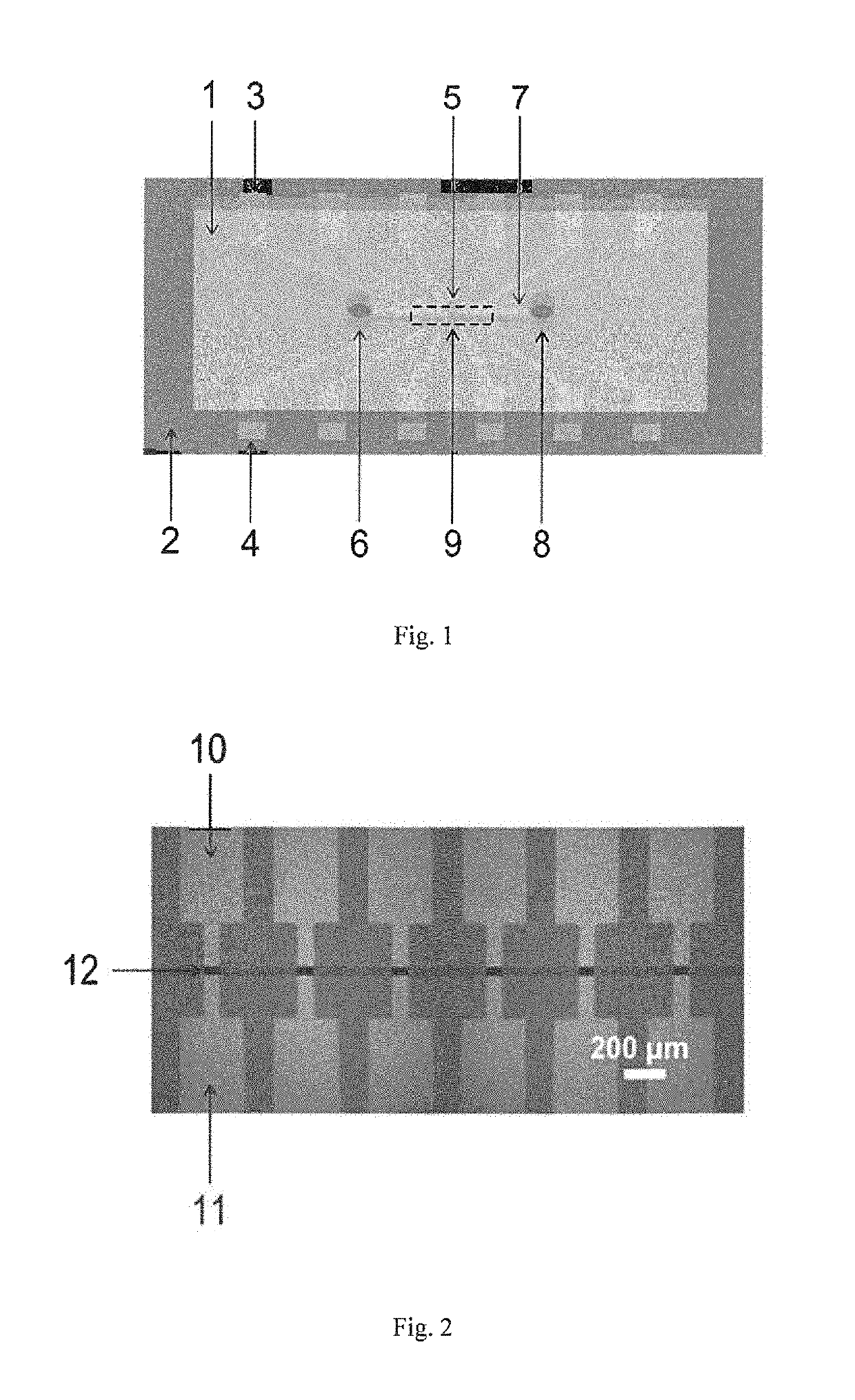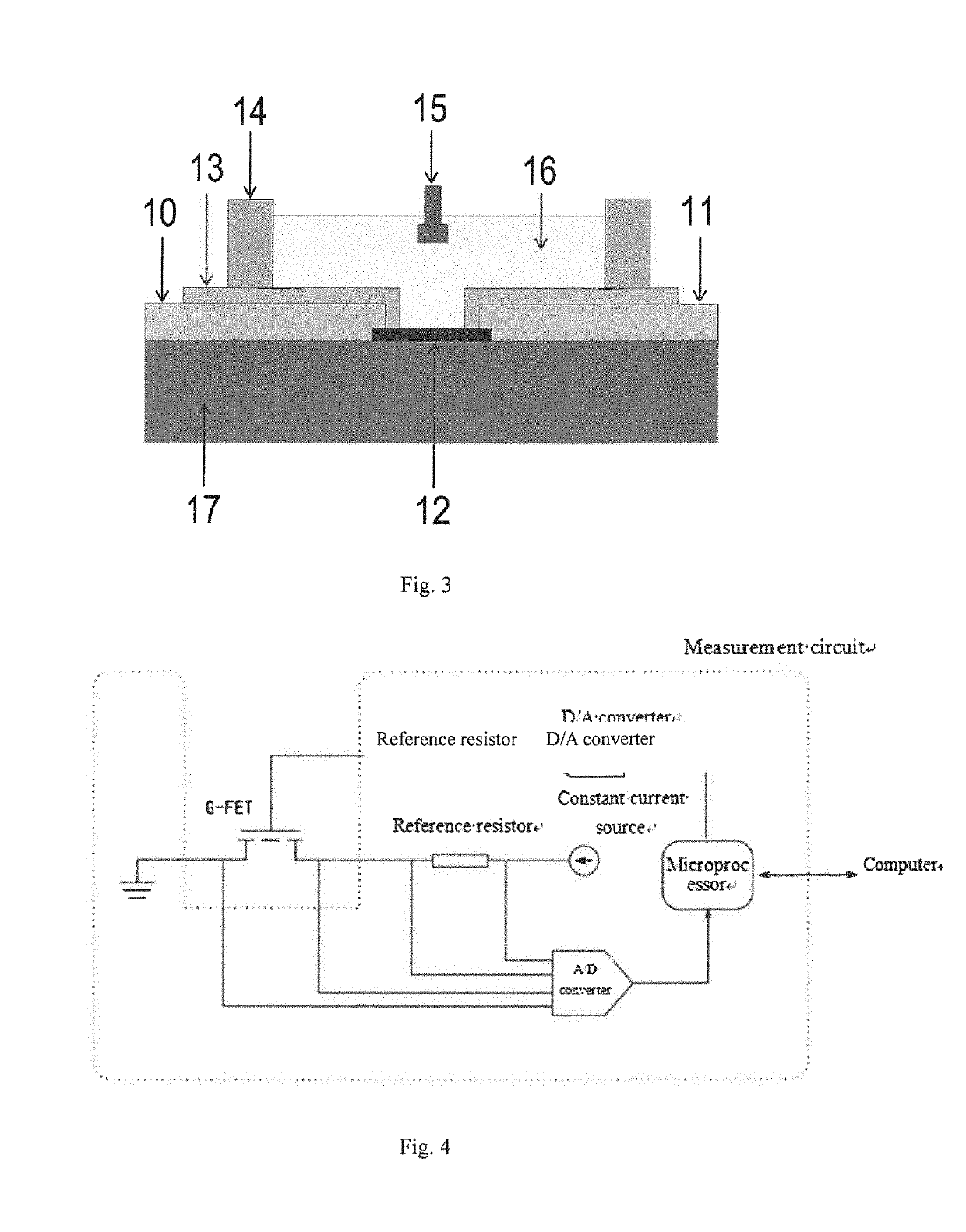Sensing device and method in detecting binding affinity and binding kinetics between molecules
a sensing device and molecule technology, applied in measurement devices, scientific instruments, instruments, etc., can solve the problems of destroying the intrinsic structure of graphene, destroying the sensitivity and accuracy of the device, and difficult to achieve low cost, so as to improve the signal-to-noise ratio and the sensitivity of the graphene, improve the sensitivity and stability of the device, and ensure the reliability of the measurement result.
- Summary
- Abstract
- Description
- Claims
- Application Information
AI Technical Summary
Benefits of technology
Problems solved by technology
Method used
Image
Examples
embodiment 1
[0080]A sensing device in detecting binding affinity and binding kinetics between molecules, as shown in FIGS. 1 and 5, includes a sensor 2 and a microfluidic chip 1; and
as shown in FIG. 2, multiple field effect transistors are arranged on the sensor 2, the multiple field effect transistors are arranged into a field effect transistor array 9, each field effect transistor is provided with a conductive channel composed of single-layer single crystal graphene 12, and all field effect transistor arrays form multiple parallel detection channels. The used single-layer single crystal grapheme is as shown in FIG. 6.
[0081]A groove 7, a sample inlet 6, a sample outlet 8 and a gate inlet 5 are formed in the microfluidic chip 1, the sample inlet 6, the sample outlet 8 and the gate inlet 5 are formed in the upper side of the microfluidic chip 1, and the sample inlet 6 and the sample outlet 8 respectively communicate both ends of the groove 7; and
the sensor 2 is installed on one side of the micro...
embodiment 2
[0086]The DNA hybridization affinity of using the device of the embodiment 1. The process of fixing probe molecules to the surface of the graphene and binding molecules to be tested with the probe molecules is shown in FIG. 7.
[0087](1) a dimethylformamide (DMF) solution of 10 mM 1-pyrenebutyric acid succinamide ester (PBASE) is injected into the surface of the graphene single crystal by using an injection pump through the microfluidic chip, pure DMF is injected to wash away the excess PBASE after incubation at the room temperature for 1 h; 100 mM 5′ terminal aminated single-stranded DNA (sequence: H2N—(CH2)6-5′-GAGTTGCTACAGACCTTCGT-3′, serial number: P20) aqueous solution is injected into the surface of the graphene, incubation is performed at the room temperature for 6 h to fix a DNA probe P20 to the surface of the graphene single crystal;
[0088](2) the DNA to be tested (sequence: 3′-CTCAACGATGTCTGGAAGCA-5′, serial number: T 20) is added into a 0.01×PBS buffer solution to prepare a ...
embodiment 3
[0092]The difference between complete match I)NA hybridization and single site mismatch hybridization is compared by using the device of the embodiment 1.
[0093]As described in the embodiment 2, the difference lies in that:
[0094]In step (1), the concentration of the PRASE is 5 mM, and the 5′ terminal aminated single-stranded DNA (sequence: H2N—(CH2)6-5′-ACCAGGCGGCCGCACACGTCCTCCAT-3′; serial number: P26);
[0095]In the step (2), the DNA to be tested are complete match DNA (sequence: 3′-TGGTCCGCCGGCGTGCAGGAGGTA-5′, serial number: T26) and single site mismatch DNA (sequence: 3′-TGGTCCGCCGGCGCGTGCAGGAGGTA-5′, serial number: T26 (TC13); the concentrations of the two DNA sample solutions to be tested are 5 nM;
[0096]Step (3) is the same as the embodiment 2, and the fitting results are shown in the following table:
TABLE 2Kinetic parameters and equilibrium constants ofhybridization of P26-T26 and P26-T26 (TC13)ka (×105 M−1 s−1)kd (×10−4 s−1)KA (×109 M−1)P26-T 262.87 (0.18)9.26 (0.13)3.10 (0.21)...
PUM
 Login to View More
Login to View More Abstract
Description
Claims
Application Information
 Login to View More
Login to View More - R&D
- Intellectual Property
- Life Sciences
- Materials
- Tech Scout
- Unparalleled Data Quality
- Higher Quality Content
- 60% Fewer Hallucinations
Browse by: Latest US Patents, China's latest patents, Technical Efficacy Thesaurus, Application Domain, Technology Topic, Popular Technical Reports.
© 2025 PatSnap. All rights reserved.Legal|Privacy policy|Modern Slavery Act Transparency Statement|Sitemap|About US| Contact US: help@patsnap.com



